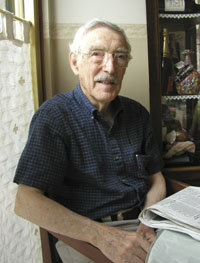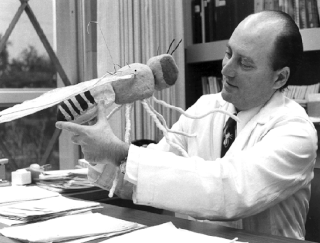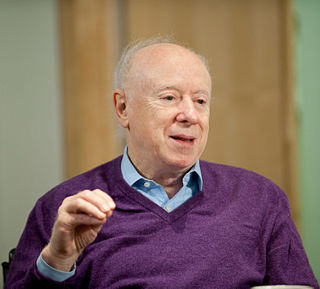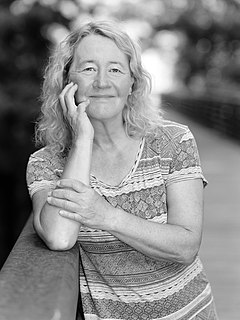Related Research Articles

Bruce Nathan Ames is an American biochemist. He is a professor of Biochemistry and Molecular Biology Emeritus at the University of California, Berkeley, and was a senior scientist at Children's Hospital Oakland Research Institute (CHORI). He is the inventor of the Ames test, a system for easily and cheaply testing the mutagenicity of compounds.

Seymour Benzer was an American physicist, molecular biologist and behavioral geneticist. His career began during the molecular biology revolution of the 1950s, and he eventually rose to prominence in the fields of molecular and behavioral genetics. He led a productive genetics research lab both at Purdue University and as the James G. Boswell Professor of Neuroscience, Emeritus, at the California Institute of Technology.

Joseph Leonard Goldstein ForMemRS is an American biochemist. He received the Nobel Prize in Physiology or Medicine in 1985, along with fellow University of Texas Southwestern researcher, Michael Brown, for their studies regarding cholesterol. They discovered that human cells have low-density lipoprotein (LDL) receptors that remove cholesterol from the blood and that when LDL receptors are not present in sufficient numbers, individuals develop hypercholesterolemia and become at risk for cholesterol related diseases, notably coronary heart disease. Their studies led to the development of statin drugs.

Robert G. Roeder is an American biochemist. He is known as a pioneer scientist in eukaryotic transcription. He discovered three distinct nuclear RNA polymerases in 1969 and characterized many proteins involved in the regulation of transcription, including basic transcription factors and the first mammalian gene-specific activator over five decades of research. He is the recipient of the Gairdner Foundation International Award in 2000, the Albert Lasker Award for Basic Medical Research in 2003, and the Kyoto Prize in 2021. He currently serves as Arnold and Mabel Beckman Professor and Head of the Laboratory of Biochemical and Molecular Biology at The Rockefeller University.
Tak Wah Mak, is a Canadian medical researcher, geneticist, oncologist, and biochemist. He first became widely known for his discovery of the T-cell receptor in 1983 and pioneering work in the genetics of immunology. In 1995, Mak published a landmark paper on the discovery of the function of the immune checkpoint protein CTLA-4, thus opening the path for immunotherapy/checkpoint inhibitors as a means of cancer treatment. Mak is also the founder of Agios Pharmaceuticals, whose lead compound, IDHIFA®, was approved by the FDA for acute myeloid leukemia in August 2017, becoming the first drug specifically targeting cancer metabolism to be used for cancer treatment. He has worked in a variety of areas including biochemistry, immunology, and cancer genetics.

Oliver Smithies was a British-American geneticist and physical biochemist. He is known for introducing starch as a medium for gel electrophoresis in 1955, and for the discovery, simultaneously with Mario Capecchi and Martin Evans, of the technique of homologous recombination of transgenic DNA with genomic DNA, a much more reliable method of altering animal genomes than previously used, and the technique behind gene targeting and knockout mice. He received the Nobel Prize in Physiology or Medicine in 2007 for his genetics work.

Joan Elaine Argetsinger Steitz is Sterling Professor of Molecular Biophysics and Biochemistry at Yale University and Investigator at the Howard Hughes Medical Institute. She is known for her discoveries involving RNA, including ground-breaking insights into how ribosomes interact with messenger RNA by complementary base pairing and that introns are spliced by small nuclear ribonucleic proteins (snRNPs), which occur in eukaryotes. In September 2018, Steitz won the Lasker-Koshland Award for Special Achievement in Medical Science. The Lasker award is often referred to as the 'American Nobel' because 87 of the former recipients have gone on to win Nobel prizes.

Carolyn Widney Greider is an American molecular biologist and Nobel laureate. She joined the University of California, Santa Cruz as a Distinguished Professor in the department of molecular, cell, and developmental biology in October 2020.

Carolyn Ruth Bertozzi is an American chemist and Nobel laureate, known for her wide-ranging work spanning both chemistry and biology. She coined the term "bioorthogonal chemistry" for chemical reactions compatible with living systems. Her recent efforts include synthesis of chemical tools to study cell surface sugars called glycans and how they impact diseases such as cancer, inflammation, and viral infections like COVID-19. At Stanford University, she holds the Anne T. and Robert M. Bass Professorship in the School of Humanities and Sciences. Bertozzi is also an Investigator at the Howard Hughes Medical Institute (HHMI) and is the former Director of the Molecular Foundry, a nanoscience research center at Lawrence Berkeley National Laboratory.
Fernando Nottebohm is a neuroscientist and the Dorothea L. Leonhardt Professor at Rockefeller University, as well as being head of the Laboratory of Animal Behavior and director of the Field Research Center for Ecology and Ethology.

Arthur L. Horwich is an American biologist and Sterling Professor of Genetics and Pediatrics at the Yale School of Medicine. Horwich has also been a Howard Hughes Medical Institute investigator since 1990. His research into protein folding uncovered the action of chaperonins, protein complexes that assist the folding of other proteins; Horwich first published this work in 1989.
Franz-Ulrich Hartl is a German biochemist and Managing Director of the Max Planck Institute of Biochemistry. He is known for his pioneering work in the field of protein-mediated protein folding and is a recipient of the 2011 Lasker Award along with Arthur L. Horwich.
Nahum Sonenberg, is an Israeli Canadian microbiologist and biochemist. He is a James McGill professor of biochemistry at McGill University in Montreal, Quebec, Canada. He was an HHMI international research scholar from 1997 to 2011 and is now a senior international research scholar. He is best known for his seminal contributions to our understanding of translation, and notable for the discovery of the mRNA 5' cap-binding protein, eIF4E, the rate-limiting component of the eukaryotic translation apparatus.
Stephen Joseph Elledge is an American geneticist. He is currently the Gregor Mendel Professor of Genetics and Medicine in the Department of Genetics at Harvard Medical School and in the Division of Genetics at the Brigham and Women's Hospital, and is an Investigator with the Howard Hughes Medical Institute. He earned his B.Sc. in chemistry from the University of Illinois at Urbana–Champaign and his Ph.D. in biology from MIT. His research is focused on the genetic and molecular mechanisms of eukaryotic response to DNA damage. He is a member of the National Academy of Sciences and has been a Howard Hughes Medical Institute (HHMI) investigator since 1993.
Howard Ronald Kaback was an American biochemist, known for Kabackosomes, the cell-free membrane transport vesicles. He was the brother of Michael M. Kaback, pediatrician and human geneticist, who developed a screening program to detect and prevent Tay–Sachs disease, a rare and fatal genetic disorder most common in Ashkenazi Jews.

G. Marius Clore MAE, FRSC, FRS is a British-born, Anglo-American molecular biophysicist and structural biologist. He was born in London, U.K. and is a dual US/U.K. Citizen. He is a Member of the National Academy of Sciences, a Fellow of the Royal Society, a NIH Distinguished Investigator, and the Chief of the Molecular and Structural Biophysics Section in the Laboratory of Chemical Physics of the National Institute of Diabetes and Digestive and Kidney Diseases at the U.S. National Institutes of Health. He is known for his foundational work in three-dimensional protein and nucleic acid structure determination by biomolecular NMR spectroscopy, for advancing experimental approaches to the study of large macromolecules and their complexes by NMR, and for developing NMR-based methods to study rare conformational states in protein-nucleic acid and protein-protein recognition. Clore's discovery of previously undetectable, functionally significant, rare transient states of macromolecules has yielded fundamental new insights into the mechanisms of important biological processes, and in particular the significance of weak interactions and the mechanisms whereby the opposing constraints of speed and specificity are optimized. Further, Clore's work opens up a new era of pharmacology and drug design as it is now possible to target structures and conformations that have been heretofore unseen.

Harry Schachter FRSC is a Canadian biochemist and glycobiologist, and professor emeritus at the University of Toronto and the Hospital For Sick Children in Toronto, Canada.
Harold Edwin Umbarger was an American bacteriologist and biochemist.
Rosalind Hauk Kornfeld (1935–2007) was a scientist at Washington University in St. Louis known for her research determining the structure and formation of oligosaccharides. The Society of Glycobiology annually awards a lifetime achievement award in her honor.
Catherine E. Costello is the William Fairfield Warren distinguished professor in the Department of Biochemistry, Cell Biology and Genomics, and the director of the Center for Biomedical Mass Spectrometry at the Boston University School of Medicine.
References
- ↑ "Biography of Professor Dr. Saul Roseman". Glycoconjugate Journal. 20 (1): 7. 2003. doi:10.1023/B:GLYC.0000016750.06379.10. ISSN 0282-0080. S2CID 43075241.
- ↑ Simoni, Robert D. (2011-11-08). "Saul Roseman: His many contributions to biochemistry over eight decades". Proceedings of the National Academy of Sciences. 108 (45): 18219–18220. Bibcode:2011PNAS..10818219S. doi: 10.1073/pnas.1116475108 . ISSN 0027-8424. PMC 3215078 . PMID 22032927.
- ↑ Schnaar, R. L.; Jourdian, G. W. (2011-11-01). "Obituary: Saul Roseman, 1921-2011". Glycobiology. 21 (11): 1393–1394. doi: 10.1093/glycob/cwr132 . ISSN 0959-6658. PMID 21994330.
- ↑ Kundig W, Roseman S (1971) Sugar transport. I. Isolation of a phosphotransferase system from Escherichia coli. J Biol Chem 246:1393–1406.
- ↑ Book of Members 1780–Present (PDF, 159 kB) der American Academy of Arts and Sciences (amacad.org)
- ↑ Past Rosenstiel Awards, Rosenstiel Basic Medical Sciences Research Center – Brandeis University
- ↑ Saul Roseman, Ph.D. of the Gairdner Foundation (gairdner.org)